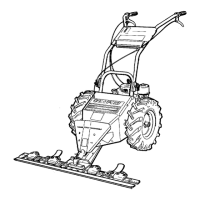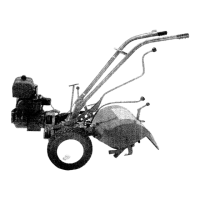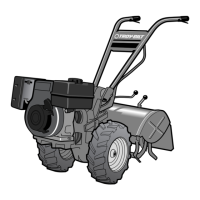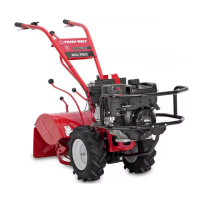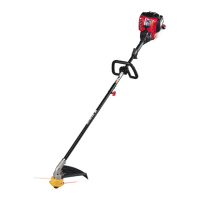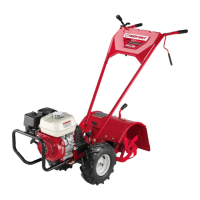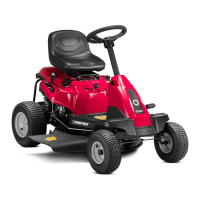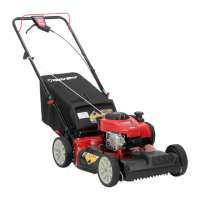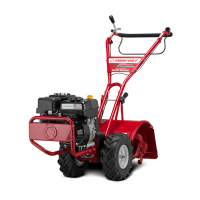But if
your
engine
won't
start in the spring,
you can drain
the
fuel
out
of
the tank and the
carburetor
bowl
too. Replace
it
with
clean,
fresh gasoline. Then, it
won't
be hard to start.
The real advantage is that
your
carburetor
seals
will be kept
moist
and gums and varnish
from
stale gasoline will
not
be formed to
gum-up
fuel lines and the carburetor passageways.
STARTING THE 6 HP ENGINE
First make sure
that
the
tiller
Wheel Speed
Shift Lever is in
slow
speed
and
the
Forward/
Reverse Lever
is
in
Neutral before starting the
engine.
1. Push the
throttle
lever
to
the left. to a slow
running position. Then. push the choke lever in
to FULL
CHOKE
(for
a cold engine).
2.
Pull
gently
on the starter rope
for
a few inches
until you feel a resistance, then give the starter
rope a quick, firm pUll. On Electric Start Models,
turn
the
key to
"START"
and hold it there
momentarily. Release the key when
the
engine
starts.
3.
As soon
as
the engine fires and is running,
make sure that the
throttle
lever
is
at a slow run-
ning position and move the choke to HALF
CHOKE briefly. Then
as
the engine warms,
move the choke to the OFF position. It's a
good
practice
to
let
your
engine run a good
two
or
three minutes before starting
tilling
operations.
Never till unless
the
choke
is
OFF.
After the engine has been operating
for
ten
minutes
or
more in the garden. it probably
won't be necessary to choke the engine at all to
restart it.
STOPPING THE ENGINE
1. Push the throttle lever on the handle all the
way forward (to the right). This lever will move
the throttle wire and the remote speed
control
lever to the
front
where the lever
contacts
the
shutoff
clip, and stops the engine automatical-
ly. If
your
engine does
not
shut
down
under
these circumstances, push the
choke
in to
FULL CHOKE
to
stop
the engine, and
See
the
data and Photo 7/63 in this manual
for
further
advice. The lever must
contact
the
shutoff
switch
(Photo 4/13).
OWNERS PLEASE NOTE:
A
properly
adjusted Forward/Reverse Lever
should make emergency engine shut-offs
un-
necessary. You should always be able
to
stop
tiller
motion
with
the Forward/Reverse Lever by
lifting the lever into
the
Neutral position. This
action will
stop
all machine
motion
except the
engine, the engine pulley and belts. The belts,
however,
will
not
provide power
to
make the
tiller
move
while
the lever is in Neutral. See
Photo 4/22.
ELECTRIC START SYSTEM ON
6 HP TECUMSEH ENGINE
For
hookup
and preparation
of
your
12-volt
battery electric start system, please see Section
1,
page
24.
For service and maintenance and
for
operation
of
the engine
without
a battery
or
with
a dead battery, see note on page
27.
For
storage
of
your
tiller
with electric start remove
battery and store in cool,
dry
place. Tempera-
tures
for
storage ranging from 10°F
to
45°
Fare
best, as long
as
your
battery acid retains its
state
of
charge. You can even store the battery
outdoors
(in a safe place). If the state
of
charge
is
very low when temperatures below freezing
occur, you
could
damage the battery. Never
store a battery
indoors
in a warm place
for
ex-
tended periods.
When the
tiller
is
not
going
to
be used
for
two
or
three months,
or
extended periods such
as
over the winter, remove the battery
from
its
mounting.
If it
is
convenient
for
you
to
check
the battery's
condition
every 3
or
4 weeks,
you
could
hook
the battery back
up
to
the
tiller's electric start
system. Then, you
could
start
the
engine on
your
tiller
(outdoors) and run it
for
45
to
60
minutes at intermediate speed. If the engine
is
started easily with
the
battery, and the battery
aC,id
level in each cell is
up
between the acid
level lines, then that's reasonable evidence that
everything
is
O.K.
IMPORTANT: Check battery acid level every
10
hours
of
tiller
operation.
47
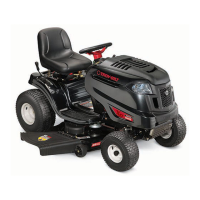
